A Typographically Unique Tour of the PPA
A unique feature of the Princeton Prosody Archive is its hand-curated, hand-tagged “collections” that act as tags and filters to aid users in narrowing down their search results. Most of these collections are relatively self-explanatory: dictionary, literary, linguistic, etc. “Typographically Unique” (TU), however, requires a bit of digging on PPA’s “Collections” information page. Here, the TU collection is described as “works that use musical notation, invented diacritical marks, phonetic scripts, universal alphabets, and more common marks for stress.” Though this clarification is wide-ranging, as an intern tasked with sorting through the Archive to tag documents as TU, I soon discovered its limits in categorizing many of the strange and wonderful texts I was encountering.
To complete my project, I had to dive into both the definition of “typographically unique” and the practical reasons for the tag’s existence. As I worked, I tried to keep in mind the questions I imagined Archive users would ask most often: Why is this document tagged TU? It looks normal to me! And the inverse approach, Why isn’t this TU? It’s so strange! Ultimately, it was the work of digging through hundreds of examples that helped me refine my approach to categorizing TU texts—but even now, I’m still discovering fascinating, novel ways of representing prosody in print and accommodating them to my sorting process. That three-part methodology—definition, question, practice—mirrors my three goals for this essay: to demystify but also complicate the definition of “typographically unique,” to answer your questions about why a document was or was not included in this category, and to showcase some of the many marvelous texts the PPA has to offer.
First, the definition. As I mentioned above, the Archive’s description of “typographically unique” is explanatory rather than exhaustive. The label “typographically unique” alone presents an inherently definitional problem. How do we define “unique,” and against what norms? Broadly speaking, the “norm” for the PPA, an English-language archive, is a text written in English, using the characters of the English alphabet, without any extra markings (other than standard punctuation) to interfere with the presentation of words or sentences—what you imagine when you think of a page of a book, article, or essay. This rules out tagging any text with sections written in other languages, or that contain scripts such as Greek, Hebrew, and Old English. But “norms” and conventions are also genre-specific, especially to reference texts. Dictionaries, for example, almost always contain phonetics and accent-indicating apostrophes. Because these features are found in dictionaries nearly universally, and readers expect to find them, they are not considered “unique.” So, not every text can be categorized with the base definition or simple questions like Does this book contain scansion? or Is there a noticeable amount of phonetic script on the page? The sorting process must take into account whether any extra markings on the page have prosodic meaning and whether they are part of formatting conventions for a reference work.
To complicate things further, there is also a practical element to the TU definition, one that is unlikely to appear in any written description. One of the reasons the TU tag exists is to identify text that OCR (optical character recognition) will struggle to read. Musical notation, scansion marks, diacritical marks, and phonetic scripts frequently interfere with this function, and where OCR fails, it becomes difficult to search inside the text or generate a text-only version of the document (as opposed to the page image thumbnails). This practical concern, used as a criterion for sorting, is a double-edged sword. If a prosodic mark falls outside the list in the TU description but befuddles PPA’s OCR, that is a good indicator that a document should be marked TU. However, some common ways of representing prosodic details such as syllabic stress or poetic feet—with slashes or apostrophes, for example—present little obstacle to a clean OCR reading. The sorting process then enters a gray area—do we categorize based on the markings, or based on the OCR performance? It varies case by case, as the gallery of PPA documents below will illustrate. In summary, however, the sorting process I ultimately developed based on these questions and considerations is illustrated in the flowchart below.
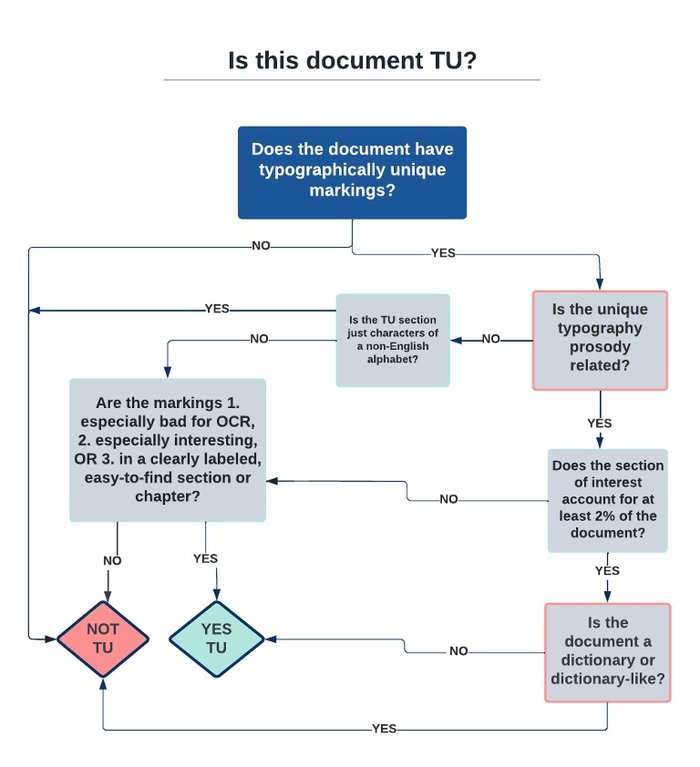
As this flowchart demonstrates, images can be far more effective in conveying schemas of categorization than written descriptions alone. Working with visual examples directly from the PPA helped clarify the gray areas that exist between the TU definition and the capabilities of PPA’s OCR—and some of them were quite fun to look at! So, with the goal of elucidating the TU category and showcasing some of the Archive’s visual gems, here is a Typographically Unique tour of the PPA!
Definitely Not TU
Let’s begin with examples that are NOT typographically unique.
First, a dictionary. As we explored above, dictionaries are rarely marked TU, because it is standard to find diacritical marks in them. Below is a page from The Imperial Dictionary. Like most dictionaries, it includes apostrophes to mark the emphasized syllables; since this is typical of dictionaries, it does not count as TU.
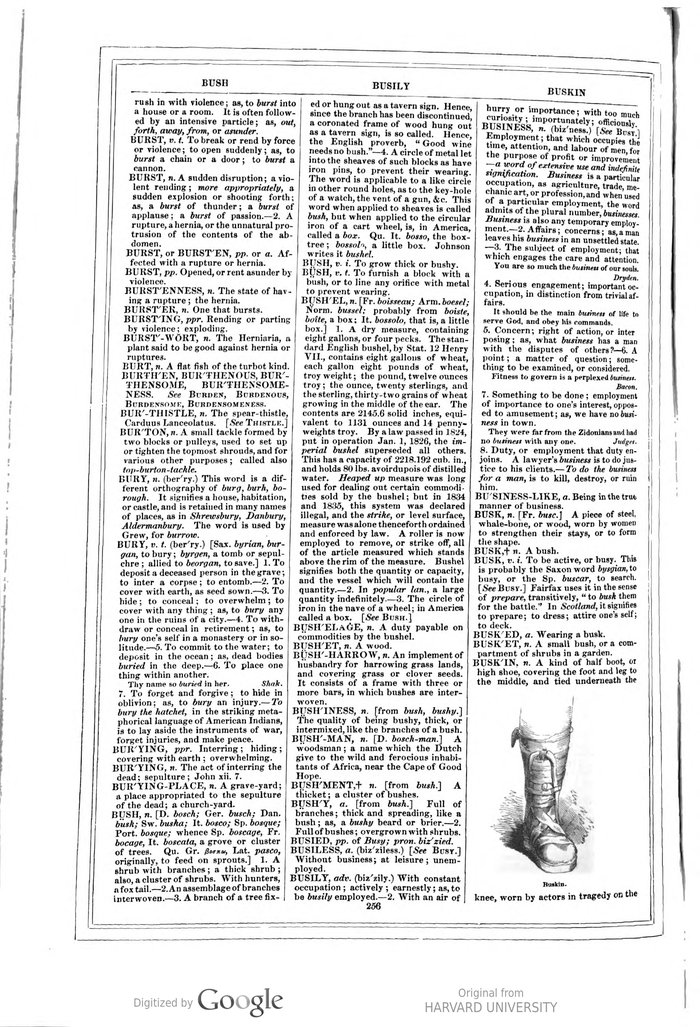
Ogilvie, John. The Imperial Dictionary, p. 265. https://prosody.princeton.edu/archive/hvd.hn61ij/
In a similar vein, there are texts in the PPA that are not technically dictionaries, but have a similar format and are primarily composed of lists of words and definitions. Below is a page from The Scholar’s Companion that looked so much like a dictionary that I classified it as not TU.
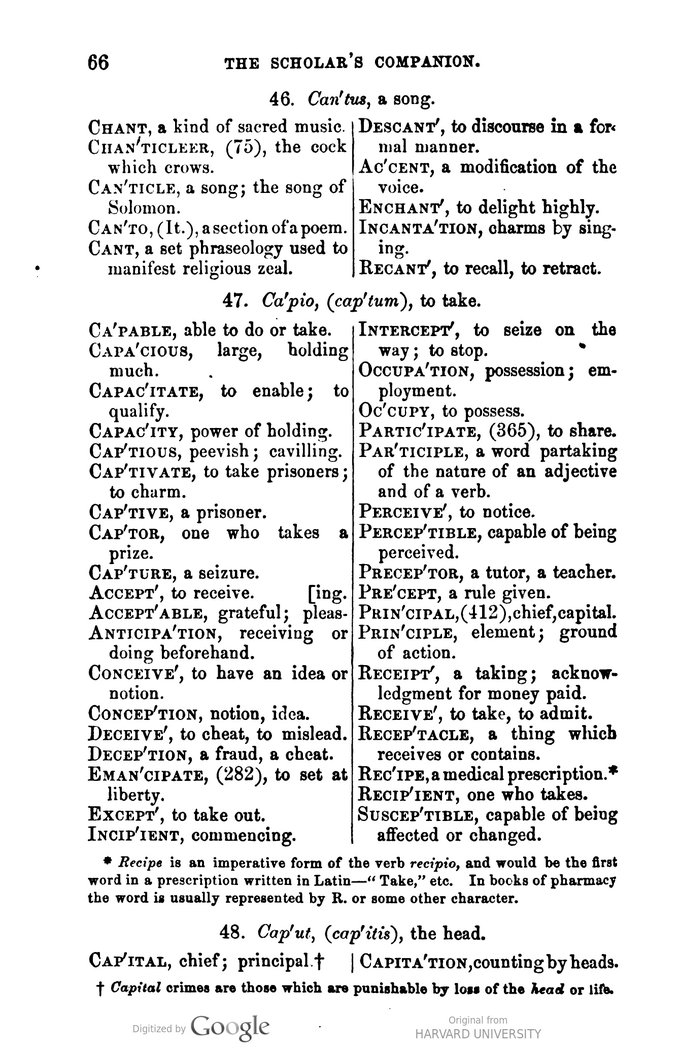
Bailey, Rufus W. The Scholar's Companion, p. 66. https://prosody.princeton.edu/archive/hvd.hn2irx/
The next example is one that contains other languages and alphabets. The Life of Saint Katherine contains parallel Latin and Old English. As you can see in the screenshot from the PPA below, HathiTrust’s OCR performs quite poorly for this page. However, since the atypical characters that interfere with OCR are simply part of the Latin and Old English alphabets, rather than serving as indicators of prosodic meaning, the document is not TU.
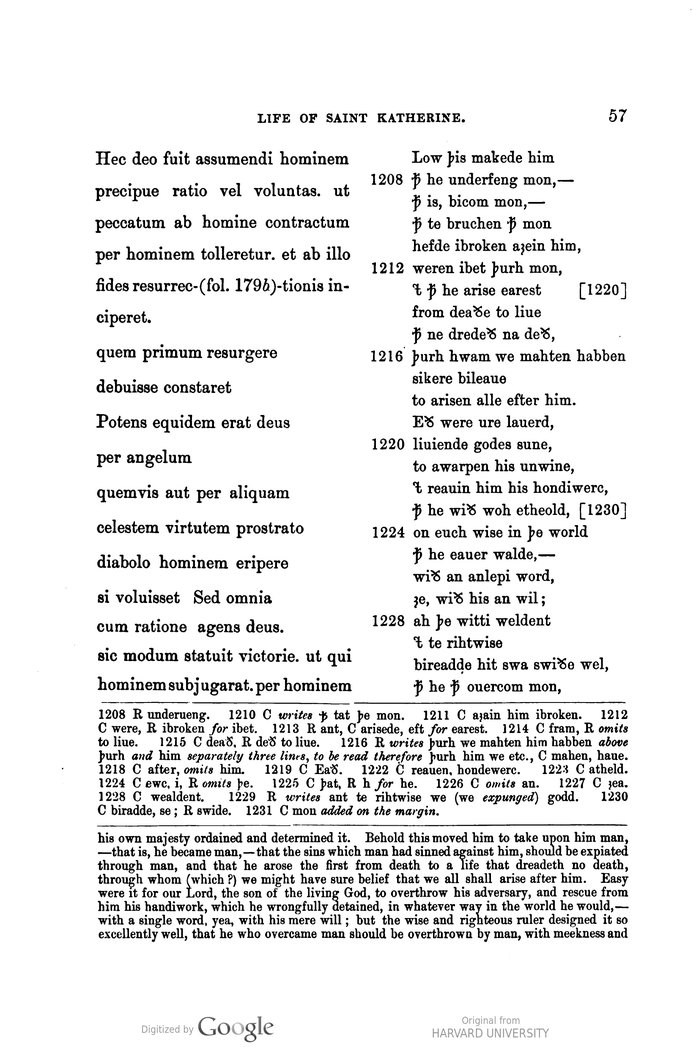
Einekel, Eugen. The Life of Saint Katherine, p. 57. https://prosody.princeton.edu/archive/hvd.hnlibf/
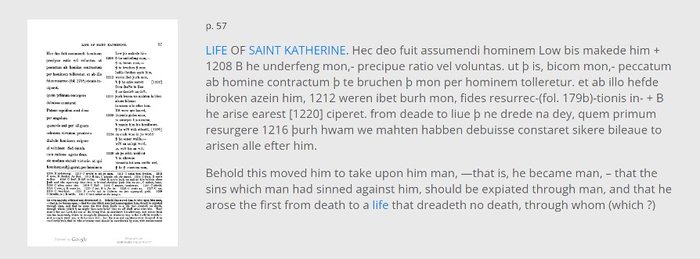
Finally, rounding out this category is an excerpt from a grammar book. This book includes sentence-parsing examples in the leftmost column. The small part-of-speech identifiers over each word interfere with OCR’s ability to scan and search the lines (as seen in the screenshot below). However, since the purpose of the parsing is grammatical rather than related to pronunciation (a definition of “prosody,” in addition to versification), it is not marked as TU.
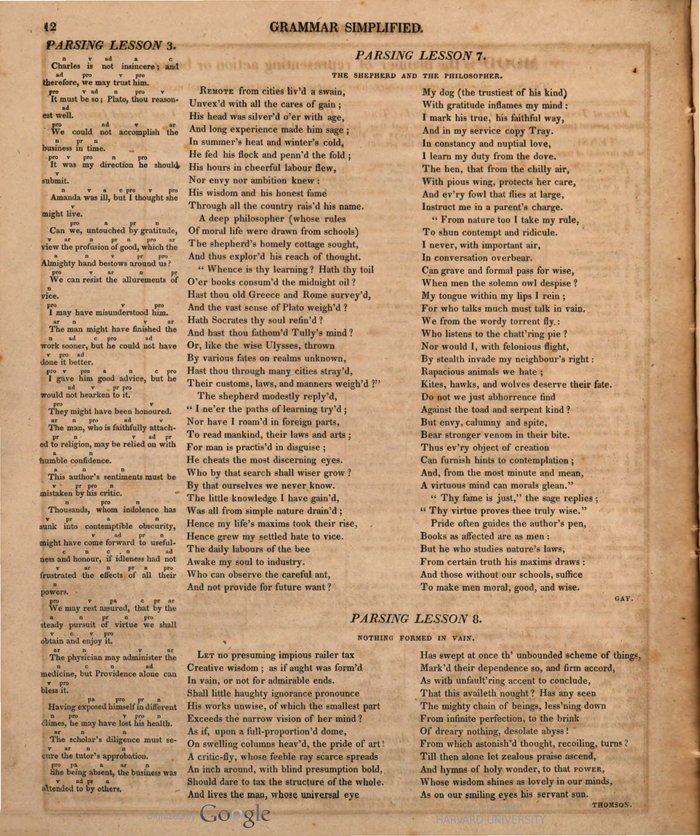
Greenleaf, Jeremiah. Grammar Simplified, or, An Ocular Analysis of the English Language, p. 12. https://prosody.princeton.edu/archive/hvd.hn38jl/

Not TU, But Prosody-Related
This next collection of images is from a category of texts with discussions of prosody, versification, meter, etc., that still do not qualify as TU. I often find texts that represent prosody on the page, but with the ordinary resources of print rather than extra markings that interfere with OCR. Bold or italic typefaces are easy ways to present poetic stress; they also appear often in speech and rhetoric manuals to highlight vowels, consonants, or syllables that should be pronounced with extra care or emphasis.
Other texts are less concerned with accent and instead focus on poetic feet. In the example from Chapters on English Metre below, vertical lines separate the various feet, which are then listed and analyzed below each excerpt. As the accompanying image from the PPA’s document reader illustrates, the OCR has no difficulty with this formatting. Therefore, it does not need to be in the TU collection!
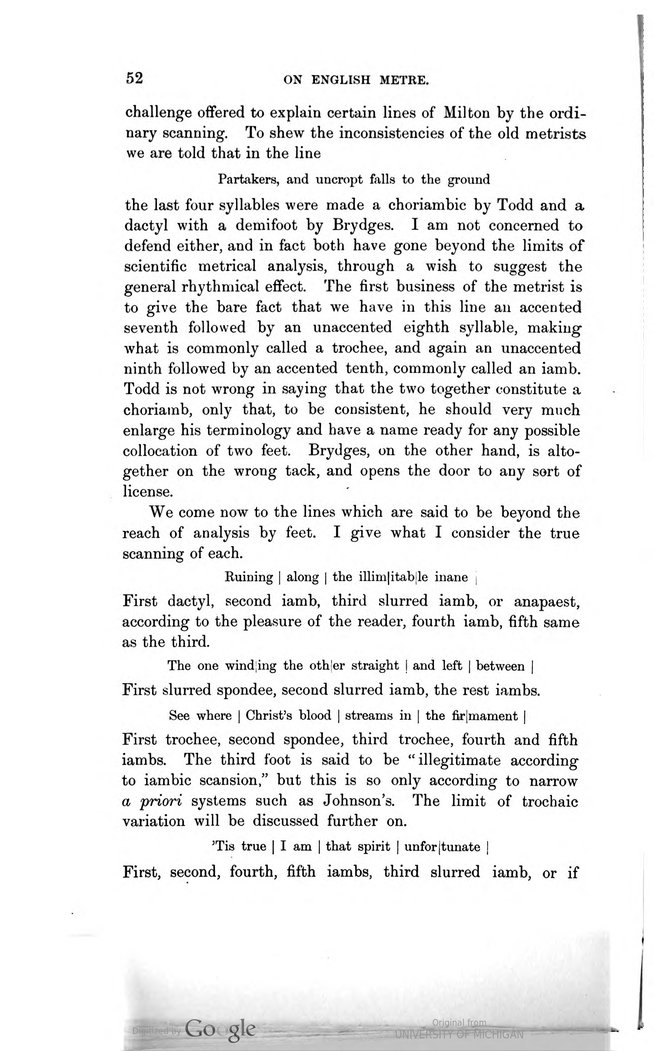
Mayor, Joseph B. Chapters on English Metre, p. 52. https://prosody.princeton.edu/archive/mdp.39015005264695/
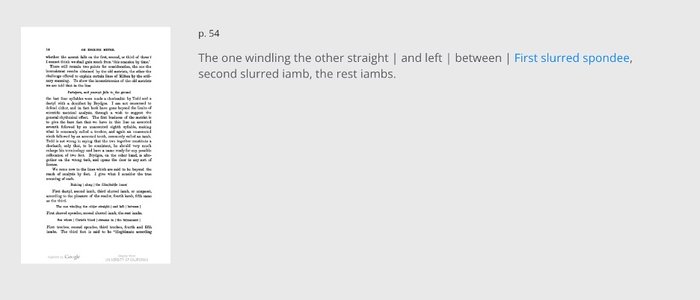
TU, But Not Enough
Of course, there are also some texts that raise the question Is this worth marking TU?; the images below represent this category. Below is an example from English Grammar in Familiar Lectures. There are a few markings to indicate stress and accent, but they are localized almost entirely to this page and part of the next, where the prosody chapter ends. This content is fascinating, but it appears on just one page in a grammar with over 200 pages. Ultimately, this section on prosody accounts for less than 1% of the book’s total content. For 99% of the book, OCR will function uninhibited, and users searching for texts with unique markings are unlikely to stumble across the few atypical lines. Therefore, I chose not to classify the text as TU. When I encounter texts like these, it is typically a quick calculation that guides my decision on how to sort them; if the TU section accounts for at least 2% of the total page count (especially if it is concentrated in a well-labeled chapter or section), I will tag it for the TU collection.
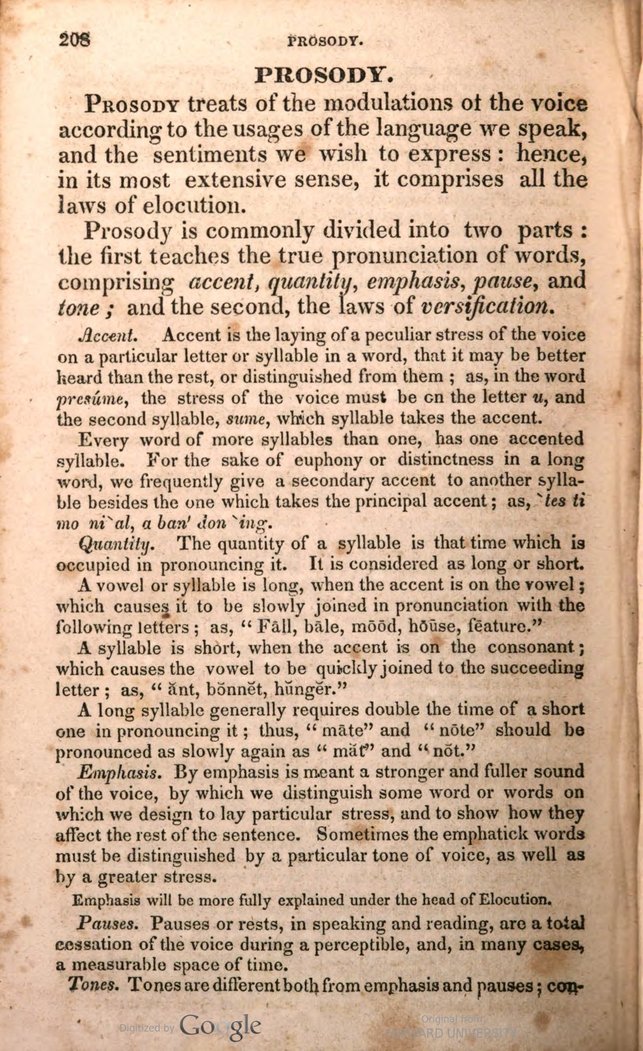
Kirkham, Samuel. English Grammar in Familiar Lectures, p. 208. https://prosody.princeton.edu/archive/hvd.hn1rpn/
The True TUs
Finally, we have the most interesting and most optically dazzling category: the true TU texts! Below are just a handful of the many curious and quirky documents you might encounter in the TU section of the PPA, examples of the creative ways authors and scholars attempt to understand, replicate, and share prosody!
Occasionally, a text that is NOT related to prosody will end up in this category simply because it is extremely creative or visually complicated. Below is such an example; it comes from a book about grammatical diagrams. Since the document contains many sentence diagrams and the diagrams interfere with OCR, it was marked TU even though the content is strictly related to grammar.
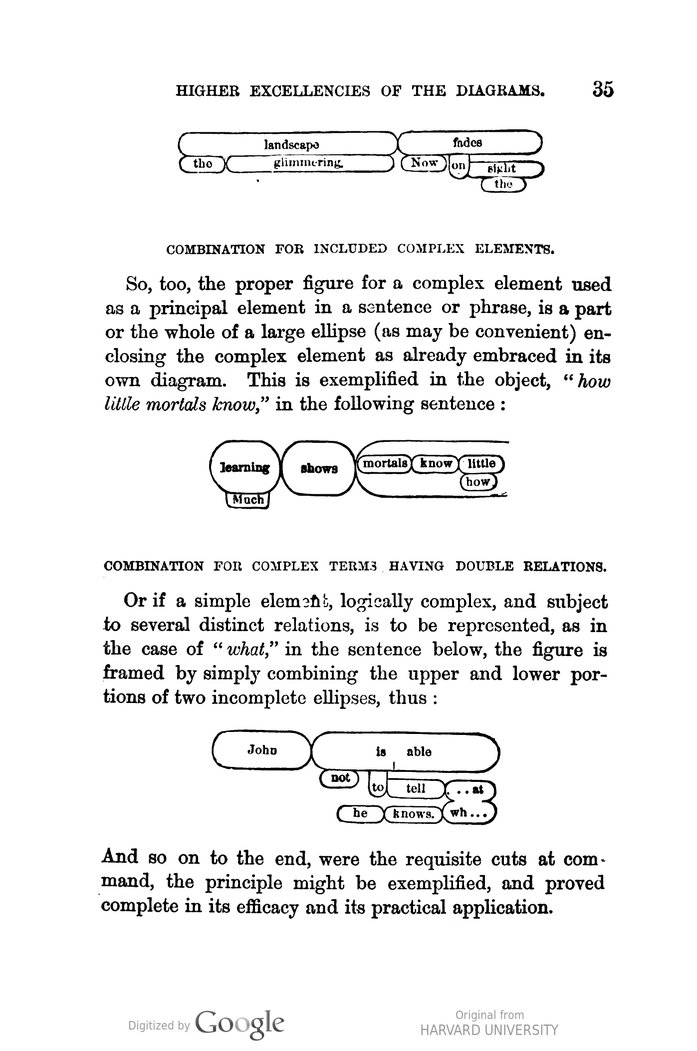
Jewell, Frederick S. Grammatical Diagrams Defended and Improved, p. 33. https://prosody.princeton.edu/archive/hvd.32044029064722/
However, texts like these are rare in the TU collection. The most common type of text in this category is one that includes scansion, in some cases recognizable now as “traditional” scansion, and in other cases another system of scansion altogether. Sometimes this scansion is accomplished with apostrophes alone, as in most dictionary pronunciation guides after the 18th century. This type of scansion falls into the gray area between the TU definition and the PPA’s OCR capabilities. OCR typically has no difficulties with apostrophes alone, and though this would usually qualify a document for the NOT TU category, the prosodic value of these simple markings is significant enough that texts that such texts are always included in the TU collection, especially since Solr strips punctuation for searching (see the first image, and the PPA screenshot, below). The middle image below is from a text that uses all of what we now recognize as the typical markings of scansion, but only when the meter diverges from a simple iambic pattern (because, after all, the PPA shows us how a system of scansion could become “typical” or “traditional”). Finally, the third image is an example of scansion on complete lines of poetry, with the addition of the vertical lines we saw earlier to separate the poetic feet.
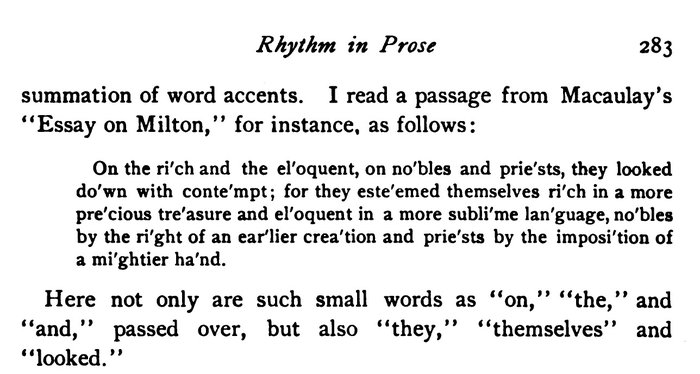
Lipsky, Abram. “Rhythm in Prose,” The Sewanee Review, vol. 16 (1908), p. 283. https://prosody.princeton.edu/archive/hvd.32044092796093-p299/

Carey, John. Key to Practical English Prosody and Versification, p. 62. https://prosody.princeton.edu/archive/hvd.hnjin7/
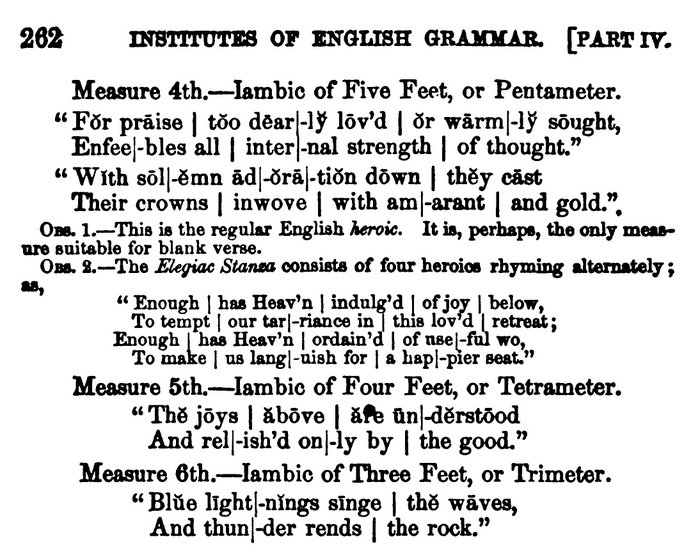
Brown, Goold. The Institutes of English Grammar, Methodically Arranged, p. 262. https://prosody.princeton.edu/archive/hvd.hw22c8/
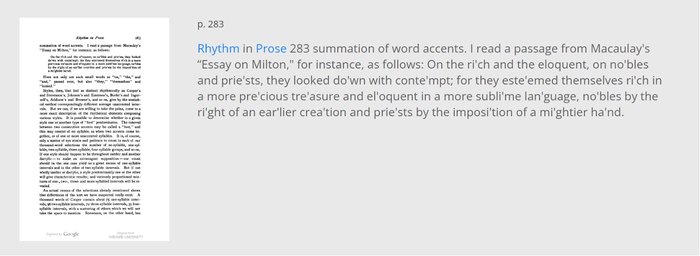
The TU collection also contains various systems for representing phonetics. The first example below uses recognizable diacritical marks carried over from Latin and Greek texts to demonstrate word pronunciation. I would usually consider the second example below to be “dictionary or dictionary-like” and not counted as TU; however, it uses a unique system of numbers to show how each vowel sound should be pronounced. Because this system is both uncommon and difficult to read with OCR, I included it in the TU collection. Finally, the third example below shows another type of phonetic-number system to demonstrate what level of stress should be placed on each syllable of the words.
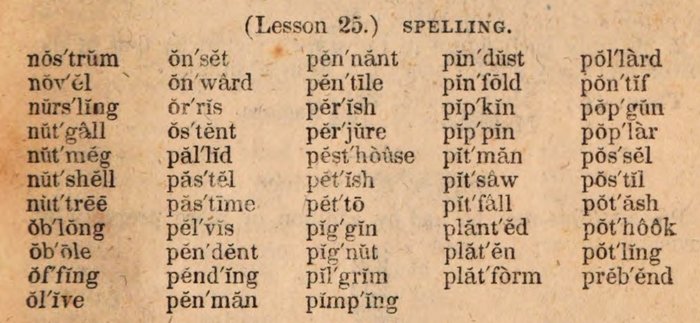
Bartlett, M.R. The Common School Manual, p. 13. https://prosody.princeton.edu/archive/hvd.32044096988480/
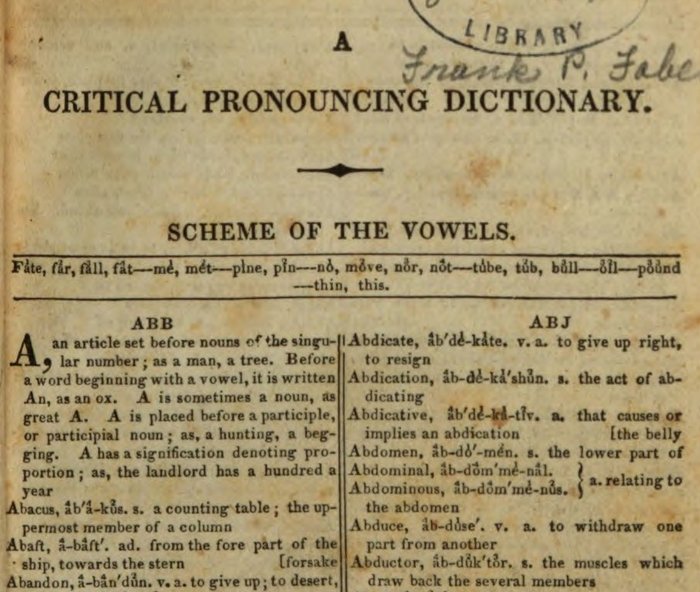
Walker, John. A Critical Pronouncing Dictionary, p. 3. https://prosody.princeton.edu/archive/hvd.hx5gb9/
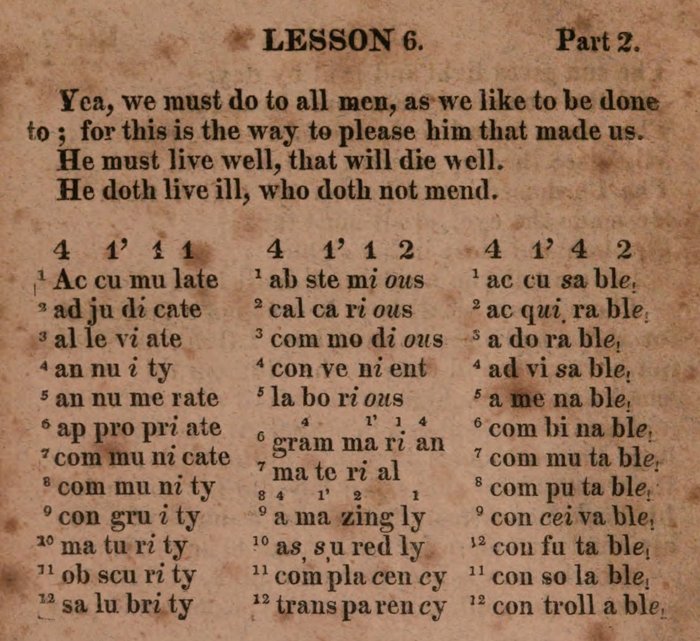
Burhans, Hezekiah. The Critical Pronouncing Spelling-Book, p. 78. https://prosody.princeton.edu/archive/hvd.32044097057558/
Many of the PPA’s rhetorical manuals employ creative solutions to reproduce the inflection changes of verbal speech-giving. The two examples below show how nonlinear text arrangements are used to illustrate how various phrases and sentences can be read aloud to produce the desired effect.

Atwell, Rev. B. W. Principles of Elocution and Vocal Culture, p. 17.
https://prosody.princeton.edu/archive/hvd.hwsk5u/
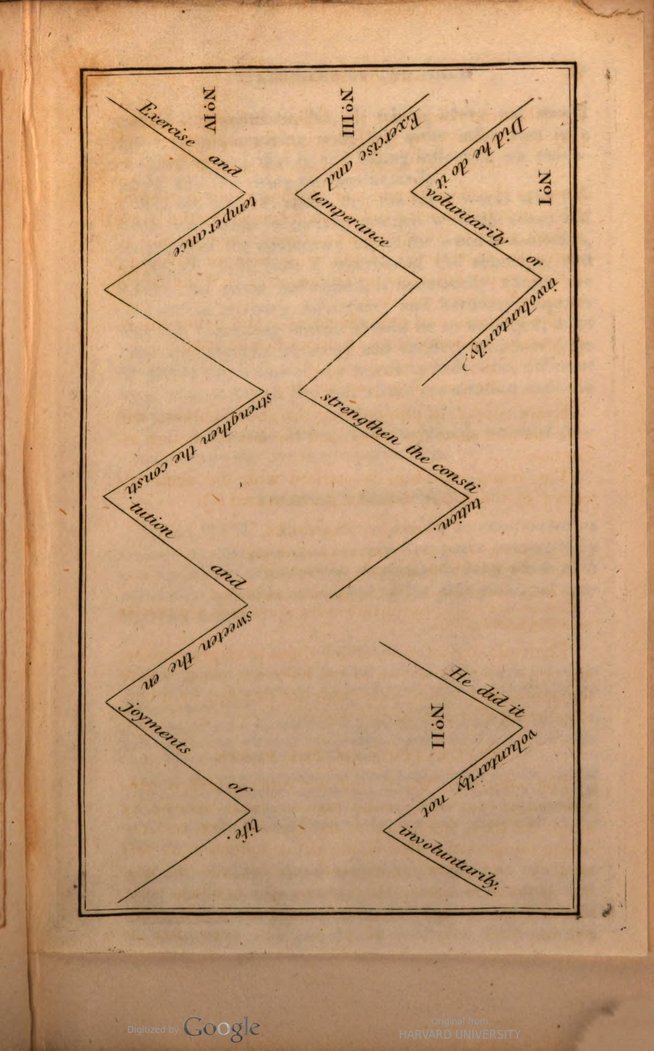
The Art of Reading, p. 14.
https://prosody.princeton.edu/archive/hvd.hn1qbp/
The examples above used inventive page layouts to capture vocal inflection, but other guides to rhetoric rely on a system of diacritical marks and symbols. Below, the author indicates how various texts and poems should be read aloud. In the book, they spend several chapters introducing various oratorical techniques and explaining the function of each marking; the examples they provide become progressively more complicated and annotated! You can see on this page the proliferation of markings intended to guide the orator on correct technique.
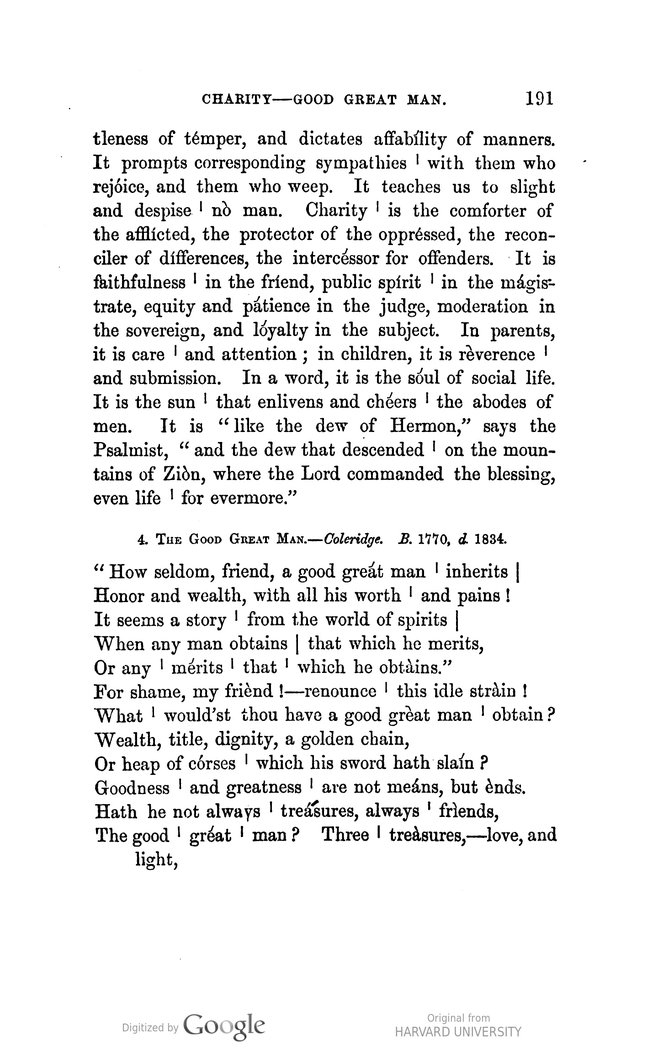
Sherwood, William. Self-Culture in Reading, Speaking, and Conversation, p. 191. https://prosody.princeton.edu/archive/hvd.32044096989116/
I stumbled across a similar system of markings in another book—but this time, the markings were hand-written! The authors of this text gave instructions for reading passages with certain emphases and inflections, and a reader marked up their copy with their interpretation of these directions. The PPA does not have another copy of this text, so users must work with the marked scans! Because the pen strokes are dark and regular enough to interfere with PPA’s OCR, this document is now tagged as TU.
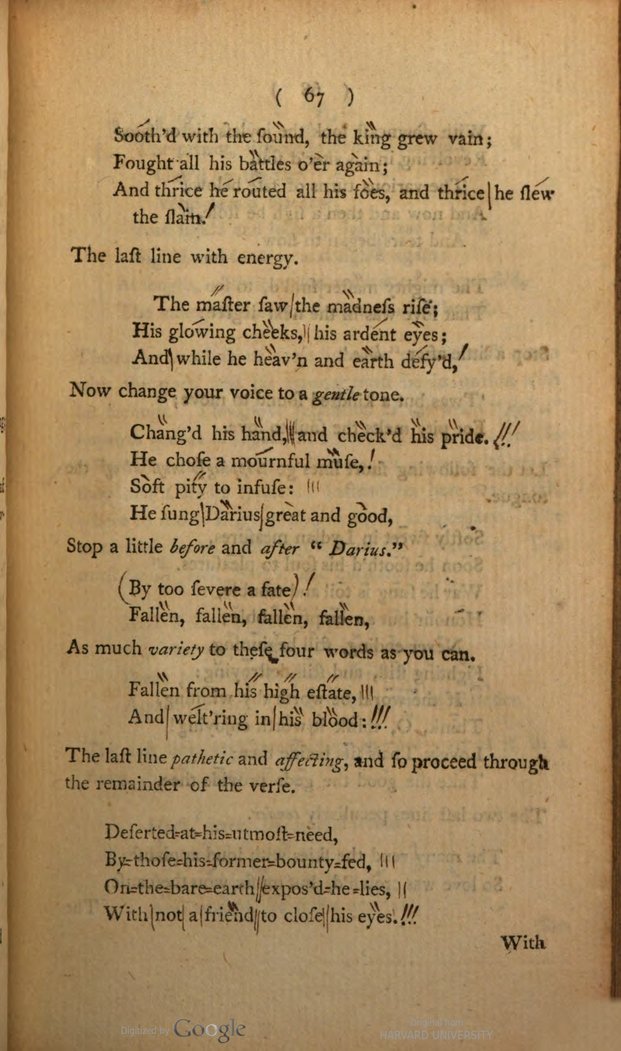
Enfield, Henderson, and Sheridan. Sheridan and Henderson’s Practical Method of Reading and Reciting English Poetry, p. 66. https://prosody.princeton.edu/archive/hvd.hn2ghn/
Some scholars have turned to music and musical notation as a way to represent prosody. The example below on the left combines scansion and musical rhythmic notation to describe the various feet and meters in Greek and Roman [Latin] poetry. Other texts use music more theoretically; the example on the right is part of a lengthy discussion on melody, harmony, and rhythm in poetry. The author references several pieces of music as examples of the aesthetic he is explaining and reproduces them in the text for readers.
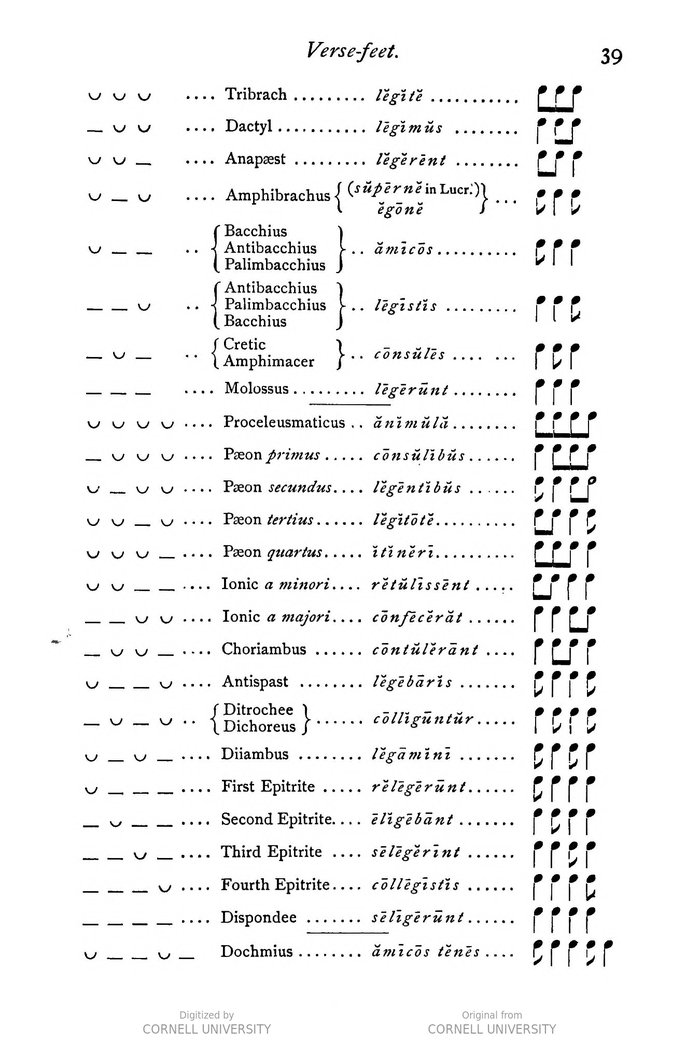
Muller, Lucian. Greek and Roman Versification, p. 39.
https://prosody.princeton.edu/archive/
coo1.ark:/13960/t4jm2tj79/
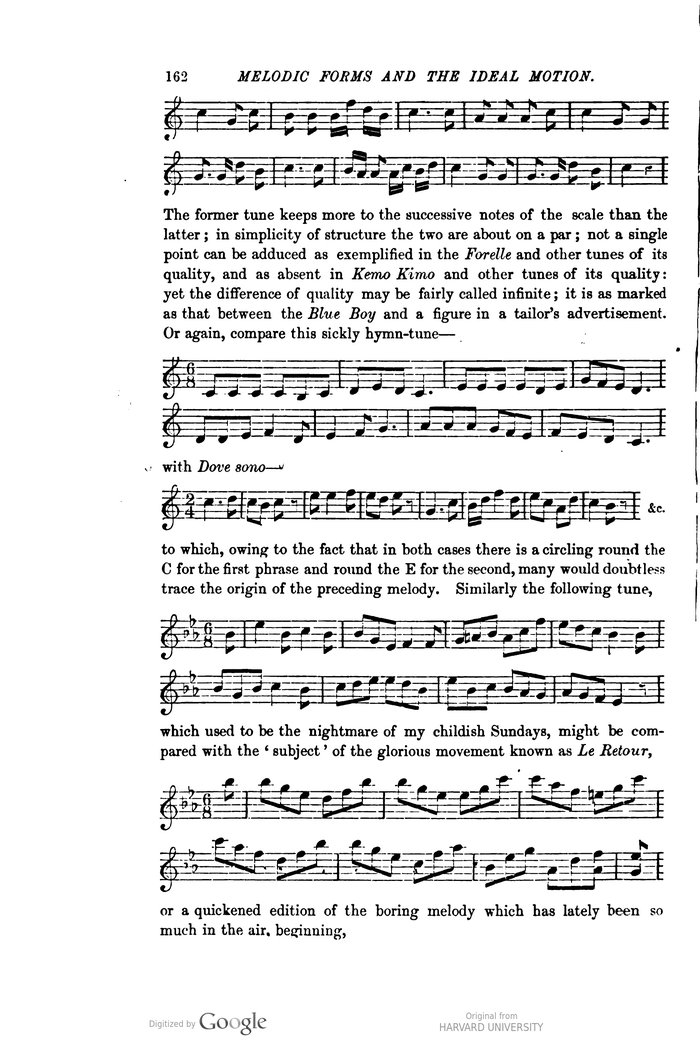
Gurney, Edmund. The Power of Sound, p. 162.
https://prosody.princeton.edu/archive/hvd.ml17qm/
Last but certainly not least, the PPA contains several specimens of prosodic systems that fit no established categories or norms. The first picture below uses dots to illustrate the relative weight of each syllable. The second picture below combines inflection and accent into word diagrams. These graphs show the inflection of each syllable on the vertical axis, the progression of the word on the horizontal axis, and stress with sideways-comma-shaped markings. Finally, the third image below captures an attempt to quantify the length of different syllables and notate rhythm without using music. The length of the vertical lines also varies to show the relative stress of each syllable.
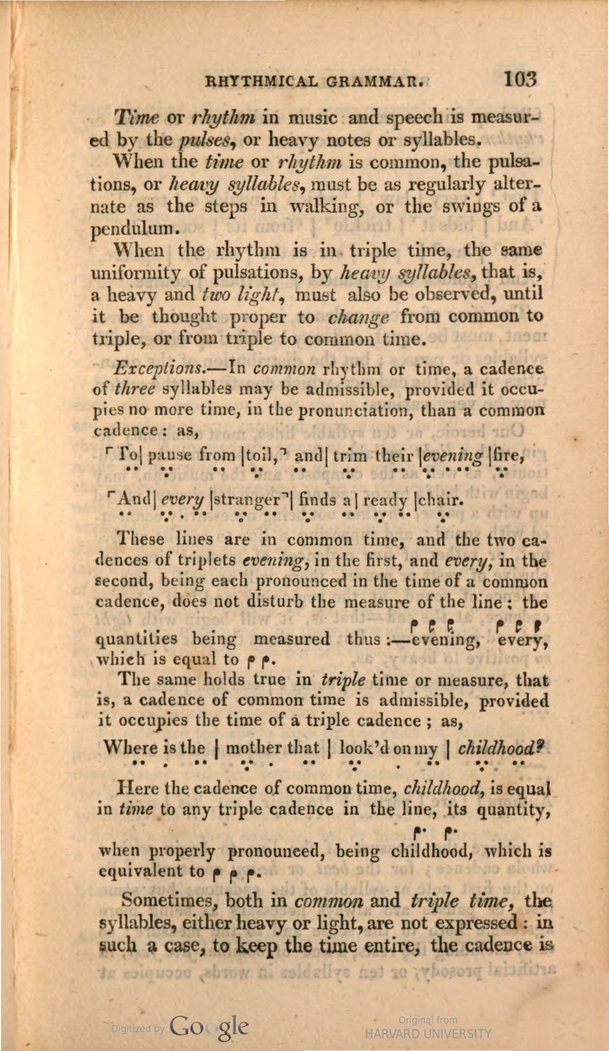
Chapman, Rev. James. The Original Rhythmical Grammar of the English Language, p. 103. https://prosody.princeton.edu/archive/hvd.hwjlql/
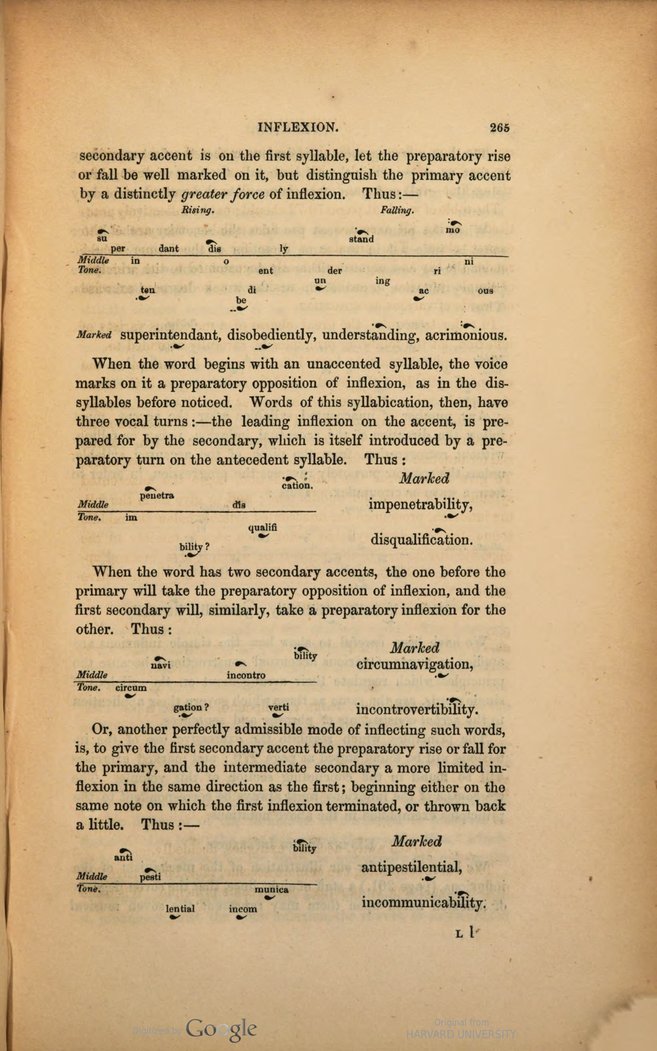
Melville, Alexander Bell. A New Elucidation of the Principles of Speech and Elocution, p. 265. https://prosody.princeton.edu/archive/hvd.ah3m3t/
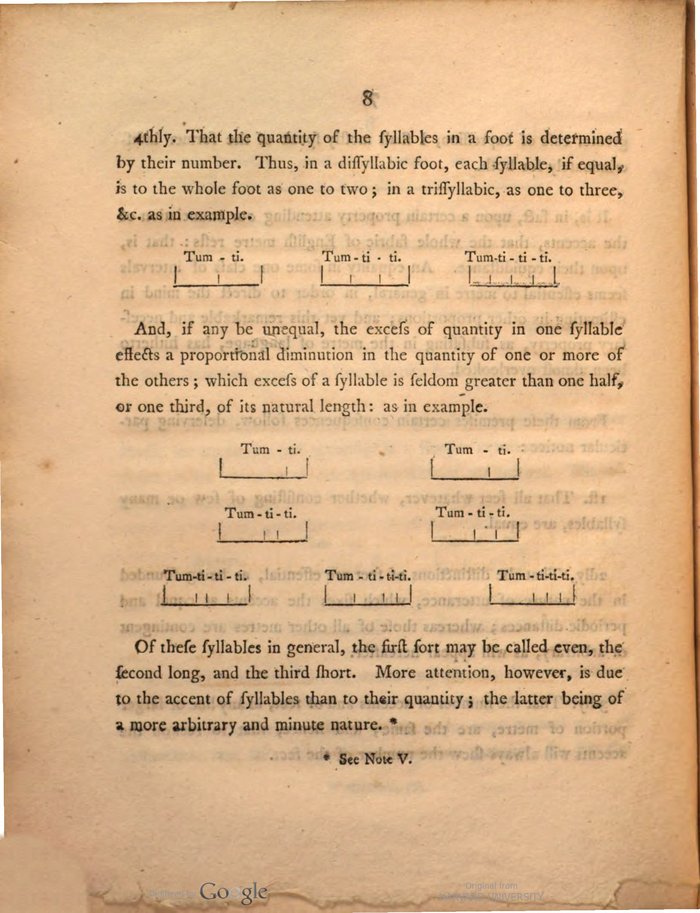
Roe, Richard. The Elements of English Metre, p. 8. https://prosody.princeton.edu/archive/hvd.hxg8hy/
That completes our TU tour of the PPA! Of course, the Archive contains far more examples of unique typography than could be explored in a single editorial essay. There are hundreds of documents in the collection waiting to be discovered, researched, and discussed!
Reflections from a TU Tagger Intern
Before interning with the PPA, I had no idea so many methods for exploring prosody existed, and I am still astounded every time I encounter a new one. But my search for TU texts has reinforced my awe at the flexibility and complexity of the English language, how it gracefully, playfully eludes all attempts to tie it to a defined system of prosody, phonetics, or rhetoric. It has also deepened my respect for apparently simple systems such as the accented/unaccented syllable scansion we usually learn. Though it surely misses some nuances, its simplicity makes it an accessible tool for students (which many grammars seem to recognize), and its ubiquity makes it an effective medium for communicating ideas about prosody. New and creative prosodic systems take pages and pages to explore and explain; yet they, too, contribute valuable details and perspectives to this inexhaustible topic.
I initially approached my task by working straight down the spreadsheet of documents in the Archive, with the hope that I would soon learn what kinds of texts and titles to look for in my search for TU documents. However, after investing hours in this method, I found that this wasn’t always the case. Texts with “music” in the title were as likely as not to contain discussions of prosody. Not every grammar had a chapter on prosody. A discussion of meter or versification might contain typographically unique marks, or the author might manage his subject without resorting to unusual marks. Or, as I found, someone might annotate the only archive copy of a text that would not otherwise have been TU. “Grammar,” “music,” “versification,” and others are still words that alert me to take a careful look at a text, and I have become more adept at skimming tables of contents to find sections with prosodic potential, but there is no algorithm for guaranteed success. Any text can contain prosodic surprises—and while that fact can make a task like categorization occasionally tedious, it has also led me to many moments of joyous discovery, often in places I least expected.
As I have come to understand it, part of my task as a TU detective is to distill that joy and discovery for the PPA’s users. When you enter the TU collection, there is still no predicting what you might find, but hopefully, if I have done my job well, there will be something worth encountering inside. That something might be a minimal component of the book or tucked away, deep in a late chapter. But ultimately, as you browse and research the Archive, I hope that you, too, get to experience the miniature thrill of stumbling across a page covered in strange dots and lines or crossing paths with a long-gone annotator. As PI Meredith Martin explains, by collecting these “typographically unique” materials, the PPA invites us to reflect on the materials that are both lost and found when we rely only on OCR. These encounters are meant to surprise us and to help us reflect on what else might remain unseen in the world of digital archives – unless we know what to look for, and how and where to look for it.
And, of course, there is always the chance you might find something we have missed. If it fits the definition and flowchart explored above, share it with us! We always aim to make the Archive as thorough and useful as possible, and that includes properly tagging our texts! Discovering the joy of prosody should be an ongoing process, and it is never too late or too trivial to share a quirky or thought-provoking way of understanding the wonder that is the English language.
Acknowledgements
Many thanks to Mary Naydan for suggesting the topic of this editorial essay, and for fielding my many questions about the definition of “typographically unique” or how to categorize rare and specific cases I encountered! Thanks are also due to Professor Meredith Martin for her editing suggestions. I would also like to acknowledge my summer 2022 co-intern Teddy Leane ’24 for his assistance on the tagging project and for finding unique examples to add to our understanding of TU and to the collection of images in this essay.
